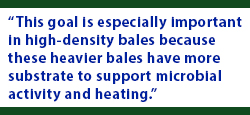
Control costs with high-density bales
 By Dr. Kevin Shinners, University of Wisconsin-Madison Biological Systems Engineering Department
By Dr. Kevin Shinners, University of Wisconsin-Madison Biological Systems Engineering Department
Large square balers have been available to hay producers for more than 40 years. In the last four decades, many improvements and innovations to these machines have been made, including new sizes, improved performance in wet hay, and integrated sensors to measure bale weight and moisture. Manufacturers now offer “conventional,” “extended,” and, more recently, “high-density” balers.
In addition to the cost of baling, hay and straw costs include those for gathering, transporting, storing, and feeding. Long-distance trucking may be another cost. The number of bales handled as well as their density and weight are important factors in these costs. For a given annual tonnage baled, switching from a conventional density 3×3 to a 3×4 reduces the bales made by about 34%. Moving from a conventional to a high-density 3×4 would roughly reduce bales made by 32%. If you currently use a 3×3 baler, switching to a conventional or extended density 3×4 could be a smart first step to reduce downstream costs after baling.
Transport weight restrictions, along with legal trailer dimensions, are used by engineers to determine the optimum bale density, which is about 15 pounds per cubic foot. Attaining this density is not difficult when baling fine-stemmed alfalfa with an extended density baler, but can be challenging no matter what type of baler is used when baling straw.
 It is recommended that moisture should be less than 18% and ideally less than 16% when hay or straw is packaged in large bales. This goal is especially important in high-density bales because these heavier bales have more substrate to support microbial activity and heating. Since attaining these moistures in hay crops is difficult in our humid climate, application of a preservative like propionic acid should be considered with high-density hay bales.
It is recommended that moisture should be less than 18% and ideally less than 16% when hay or straw is packaged in large bales. This goal is especially important in high-density bales because these heavier bales have more substrate to support microbial activity and heating. Since attaining these moistures in hay crops is difficult in our humid climate, application of a preservative like propionic acid should be considered with high-density hay bales.
To achieve greater bale density, engineers have increased bale chamber convergence and length, which results in greater back pressure, compression forces, and bale density. Greater compression forces require a larger gearbox, stronger plunger, and more robust drivelines and frame members, all of which contribute to greater retail list price for these balers. Here are some things to consider if you are thinking of moving to a high-density baler:
- Currently, high-density balers are only available in the 3×4 cross-section.
- High-density balers require larger, higher-horsepower tractors to operate.
- The purchase price of a high-density baler may be as much as 50% greater than a similarly size conventional density baler.
- High-density balers typically require twine with greater tensile strength.
- Consider the crops you bale. Density goals can often be met when baling alfalfa with an extended density baler. If straw is an important crop baled, high-density balers could be economically viable.
- Carefully calculate all your costs from baling through feeding when considering a high-density baler.
| Category: |
Equipment Forage Foundations Forage harvesting |

